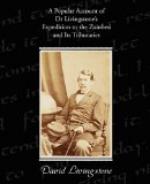On the 21st of September, we arrived at the village of the chief Muasi, or Muazi; it is surrounded by a stockade, and embowered in very tall euphorbia-trees; their height, thirty or forty feet, shows that it has been inhabited for at least one generation. A visitation of disease or death causes the headmen to change the site of their villages, and plant new hedges; but, though Muazi has suffered from the attacks of the Mazitu, he has evidently clung to his birthplace. The village is situated about two miles south-west of a high hill called Kasungu, which gives the name to a district extending to the Loangwa of the Maravi. Several other detached granite hills have been shot up on the plain, and many stockaded villages, all owing allegiance to Muazi, are scattered over it.
On our arrival, the chief was sitting in the smooth shady place, called Boalo, where all public business is transacted, with about two hundred men and boys around him. We paid our guides with due ostentation. Masiko, the tallest of our party, measured off the fathom of cloth agreed upon, and made it appear as long as possible, by facing round to the crowd, and cutting a few inches beyond what his outstretched arms could reach, to show that there was no deception. This was by way of advertisement. The people are mightily gratified at having a tall fellow to measure the cloth for them. It pleases them even better than cutting it by a tape-line—though very few men of six feet high can measure off their own length with their outstretched arms. Here, where Arab traders have been, the cubit called mokono, or elbow, begins to take the place of the fathom in use further south. The measure is taken from the point of the bent elbow to the end of the middle finger.
We found, on visiting Muazi on the following day, that he was as frank and straightforward as could reasonably be expected. He did not wish us to go to the N.N.W., because he carries on a considerable trade in ivory there. We were anxious to get off the slave route, to people not visited before by traders; but Muazi naturally feared, that if we went to what is said to be a well-watered country, abounding in elephants, we might relieve him of the ivory which he now obtains at a cheap rate, and sells to the slave-traders as they pass Kasungu to the east; but at last he consented, warning us that “great difficulty would be experienced in obtaining food—a district had been depopulated by slave wars—and a night or two must be spent in it; but he would give us good guides, who would go three days with us, before turning, and then further progress must depend on ourselves.” Some of our men having been ill ever since we mounted this highland plain, we remained two days with Muazi.
A herd of fine cattle showed that no tsetse existed in the district. They had the Indian hump, and were very fat, and very tame. The boys rode on both cows and bulls without fear, and the animals were so fat and lazy, that the old ones only made a feeble attempt to kick their young tormentors. Muazi never milks the cows; he complained that, but for the Mazitu having formerly captured some, he should now have had very many. They wander over the country at large, and certainly thrive.




